PI(3,5)P2 controls endosomal branched actin dynamics by regulating cortactin-actin interactions
- PMID: 26323691
- PMCID: PMC4555817
- DOI: 10.1083/jcb.201412127
PI(3,5)P2 controls endosomal branched actin dynamics by regulating cortactin-actin interactions
Abstract
Branched actin critically contributes to membrane trafficking by regulating membrane curvature, dynamics, fission, and transport. However, how actin dynamics are controlled at membranes is poorly understood. Here, we identify the branched actin regulator cortactin as a direct binding partner of phosphatidylinositol 3,5-bisphosphate (PI(3,5)P2) and demonstrate that their interaction promotes turnover of late endosomal actin. In vitro biochemical studies indicated that cortactin binds PI(3,5)P2 via its actin filament-binding region. Furthermore, PI(3,5)P2 competed with actin filaments for binding to cortactin, thereby antagonizing cortactin activity. These findings suggest that PI(3,5)P2 formation on endosomes may remove cortactin from endosome-associated branched actin. Indeed, inhibition of PI(3,5)P2 production led to cortactin accumulation and actin stabilization on Rab7(+) endosomes. Conversely, inhibition of Arp2/3 complex activity greatly reduced cortactin localization to late endosomes. Knockdown of cortactin reversed PI(3,5)P2-inhibitor-induced actin accumulation and stabilization on endosomes. These data suggest a model in which PI(3,5)P2 binding removes cortactin from late endosomal branched actin networks and thereby promotes net actin turnover.
© 2015 Hong et al.
Figures
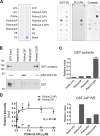
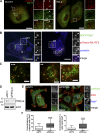
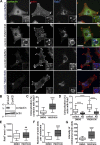
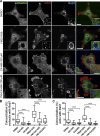
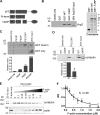
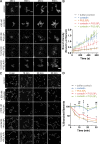

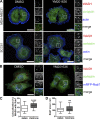

Similar articles
-
Cortactin promotes exosome secretion by controlling branched actin dynamics.J Cell Biol. 2016 Jul 18;214(2):197-213. doi: 10.1083/jcb.201601025. Epub 2016 Jul 11. J Cell Biol. 2016. PMID: 27402952 Free PMC article.
-
Protein kinase Cdelta and calmodulin regulate epidermal growth factor receptor recycling from early endosomes through Arp2/3 complex and cortactin.Mol Biol Cell. 2008 Jan;19(1):17-29. doi: 10.1091/mbc.e07-05-0411. Epub 2007 Oct 24. Mol Biol Cell. 2008. PMID: 17959830 Free PMC article.
-
Interactions with actin monomers, actin filaments, and Arp2/3 complex define the roles of WASP family proteins and cortactin in coordinately regulating branched actin networks.J Biol Chem. 2014 Oct 17;289(42):28856-69. doi: 10.1074/jbc.M114.587527. Epub 2014 Aug 26. J Biol Chem. 2014. PMID: 25160634 Free PMC article.
-
Cortactin: a multifunctional regulator of cellular invasiveness.Cell Adh Migr. 2011 Mar-Apr;5(2):187-98. doi: 10.4161/cam.5.2.14773. Epub 2011 Mar 1. Cell Adh Migr. 2011. PMID: 21258212 Free PMC article. Review.
-
Regulation of the actin cytoskeleton by PI(4,5)P2 and PI(3,4,5)P3.Curr Top Microbiol Immunol. 2004;282:117-63. doi: 10.1007/978-3-642-18805-3_5. Curr Top Microbiol Immunol. 2004. PMID: 14594216 Review.
Cited by
-
Lipid kinases VPS34 and PIKfyve coordinate a phosphoinositide cascade to regulate retriever-mediated recycling on endosomes.Elife. 2022 Jan 18;11:e69709. doi: 10.7554/eLife.69709. Elife. 2022. PMID: 35040777 Free PMC article.
-
Improved imaging and preservation of lysosome dynamics using silver nanoparticle-enhanced fluorescence.Mol Biol Cell. 2023 Sep 1;34(10):ar96. doi: 10.1091/mbc.E22-06-0200. Epub 2023 Jul 5. Mol Biol Cell. 2023. PMID: 37405751 Free PMC article.
-
The repeat region of cortactin is intrinsically disordered in solution.Sci Rep. 2017 Dec 1;7(1):16696. doi: 10.1038/s41598-017-16959-1. Sci Rep. 2017. PMID: 29196701 Free PMC article.
-
An advanced toolset to manipulate and monitor subcellular phosphatidylinositol 3,5-bisphosphate.J Cell Biol. 2025 Jun 2;224(6):e202408158. doi: 10.1083/jcb.202408158. Epub 2025 Mar 26. J Cell Biol. 2025. PMID: 40138452
-
Cortactin is in a complex with VE-cadherin and is required for endothelial adherens junction stability through Rap1/Rac1 activation.Sci Rep. 2024 Jan 12;14(1):1218. doi: 10.1038/s41598-024-51269-3. Sci Rep. 2024. PMID: 38216638 Free PMC article.
References
-
- Bird I.M. 1994. Analysis of cellular phosphoinositides and phosphoinositols by extraction and simple analytical procedures. Methods Mol. Biol. 27:227–248. - PubMed
-
- Bolino A., Muglia M., Conforti F.L., LeGuern E., Salih M.A., Georgiou D.M., Christodoulou K., Hausmanowa-Petrusewicz I., Mandich P., Schenone A., et al. . 2000. Charcot-Marie-Tooth type 4B is caused by mutations in the gene encoding myotubularin-related protein-2. Nat. Genet. 25:17–19. 10.1038/75542 - DOI - PubMed
Publication types
MeSH terms
Substances
Grants and funding
- TR000445-06/TR/NCATS NIH HHS/United States
- UL1 TR000445/TR/NCATS NIH HHS/United States
- P60 DK020593/DK/NIDDK NIH HHS/United States
- R01 CA163592/CA/NCI NIH HHS/United States
- DK58404/DK/NIDDK NIH HHS/United States
- P30 DK058404/DK/NIDDK NIH HHS/United States
- R01GM075126/GM/NIGMS NIH HHS/United States
- P30 HD015052/HD/NICHD NIH HHS/United States
- R01 HL-55672/HL/NHLBI NIH HHS/United States
- EY08126/EY/NEI NIH HHS/United States
- P30 EY008126/EY/NEI NIH HHS/United States
- DK59637/DK/NIDDK NIH HHS/United States
- P30 DK020593/DK/NIDDK NIH HHS/United States
- R01 HL055672/HL/NHLBI NIH HHS/United States
- P30 CA068485/CA/NCI NIH HHS/United States
- CA68485/CA/NCI NIH HHS/United States
- R01 GM075126/GM/NIGMS NIH HHS/United States
- UL1 RR024975/RR/NCRR NIH HHS/United States
- R01CA163592/CA/NCI NIH HHS/United States
- HD15052/HD/NICHD NIH HHS/United States
- DK20593/DK/NIDDK NIH HHS/United States
- U24 DK059637/DK/NIDDK NIH HHS/United States
LinkOut - more resources
Full Text Sources
Other Literature Sources
Molecular Biology Databases
Research Materials
Miscellaneous

